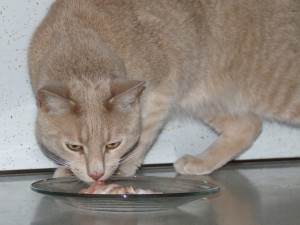Home-prepared or commercial cat food – rotate those proteins!
 I frequently get contacted by puzzled cat owners whose kitties suddenly refuse to eat the food they’ve been happily chowing down on for weeks, sometimes months.
I frequently get contacted by puzzled cat owners whose kitties suddenly refuse to eat the food they’ve been happily chowing down on for weeks, sometimes months.
The first question I always ask them is how many different “meals” they’ve been offering the cat.
Quite often, the answer is only one, maybe two, and that’s a problem.
According to “The Evolutionary Basis for the Feeding Behavior of Domestic Dogs (Canis familiaris) and Cats (Felis catus)” by John Bradshaw (2006), cats have a distinctive hunting imperative that pushes them to seek out a variety of prey animals, especially if their recent hunts have been limited to only one. This behavior has been labeled the “monotony effect” and essentially means that cats who eat the same thing too frequently or for too long will often no longer find the food appealing. The effect appears to be stronger in free-roaming cats than in those kept indoors and is influenced by what their mother ate, what they ate during their first year of life, and by negative reactions to foods, and it is endemic to all domestic cat populations.
Bradshaw’s observation makes sense in light of a 2008 study published in the Journal of Zoology that determined large wild cats like the cheetah and the lynx need between 5 and 7 different proteins to fulfill their nutritional requirements. Most experts agree that 3 to 5 are sufficient for our smaller housecats, but more is always better.
This is a basic tenant of home-preparing fresh diets. Every protein type has a particular nutrient profile and, while they all fit well as part of a cat’s diet, no single meat can serve as the cat’s sole meat source. Heart, for instance, is a great source of taurine, but it’s also comparatively high in salt, and a high-salt diet is not healthy. Chicken in high in niacin, but it’s also high in fat; while cats do require more fat in their diet than people, a steady diet of chicken is too much fat. Rabbit is often a strong favorite of cats, but it’s very lean (the opposite of chicken!) and there are indicators it may be comparatively low in taurine. And so on….
Commercial products, both raw and canned (never feed kibble), present another reason for feeding a rotation of several proteins and formula – mitigating quality control problems.
There are the intentional issues, such as with Nature’s Variety Raw Instincts products, several of which contain 15% bone. Cat only require 7-10% bone and feeding NV alone will often result in a constipated kitty. Feed it in rotation with several other products, however, and the effect of that extra bone is diluted.
And then there are the unintentional but inevitable mistakes. Too much Vitamin D in one batch, too little in another. Toxic mold or some other deadly contaminant slips in (as in the massive 2007 pet food poisoning). The potential damages from all of these issues are tempered by feeding multiple products from different manufacturers.
Lastly, cats can develop hypersensitivity when continually exposed to the same proteins or ingredients for extended periods, so providing a large variety of meals  in your cat’s diet will help prevent food intolerances as well as the associated diarrhea and vomiting.
in your cat’s diet will help prevent food intolerances as well as the associated diarrhea and vomiting.
So rotate through as many proteins as you can source, but not less than three (one for each meal of the day). You’ll keep your cats’ taste buds happy, ensure they get all their nutritional requirements met, protect them from quality-control issues AND keep them from becoming intolerant to their favorite foods. An easy fix for a multitude of complications!
If you enjoyed this post or found it informative, please “Like” it, “Tweet” it, or share it using any of the buttons below. And don’t forget to check out our FB page, join the discussions in our awesome FB group and follow us on Twitter!


It was very informative something to use for my cats.
Thanks, Anthony. Glad you found it helpful! 🙂
I took my cat to a Vet hospital (It was the only one available on Sunday) because he was throwing up constantly and diarear. Spent hours there. When time to go they came up with no diagnosis but gave me a dry prescription med. and was told to give him anything else. (It is Royal Canin Gastrointestinal ). Because my Duffy literally goes hysterical in the vets, I waited a couple of days and took him to his regular vet. He did a blood test and told me he had lymphoma and there was nothing else could be done. Just continue to give Duffy the same medicine food and nothing else else. The vet couldn’t say if my Duf had a shot life span or not. After I calmed down after this I have been doing just this and wondering if this is OK. He seems to be OK. He is eating and no throwing up like he always did most often.
Now, after a few months have passed, I am wondering why the vet hospital didn’t tell me this. Am I doing right with the food? I did not go for another opinion because it creates so much trama to Duf that I thought I would wait and see if he gets sick again. I wanted your opinion as to the feeding. Nothing in Duffy has changed since taking this food and at 15 years old, he seems to be OK.
Is it OK to keep him only on that med.
Any help would be greatly appreciated.
I’m so sorry you and Duffy are going through this, Anita. How difficult, and scary! ((HUGS))
I am, however, puzzled by the diagnosis of lymphoma based off nothing more than a blood test. Are you on Facebook? If you are, can you please join the CatCentric group? Several members, including a CatCentric contributor, have extensive experience with both lymphoma and IBD (which is often accompanied by chronic vomiting and diarrhea such as you describe).
I’ll watch for you in the group!
~Tracy